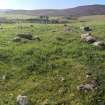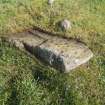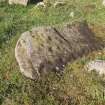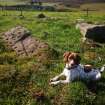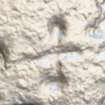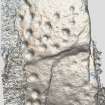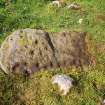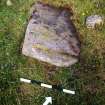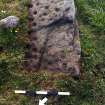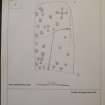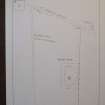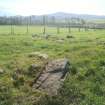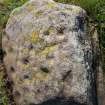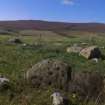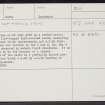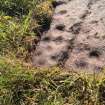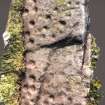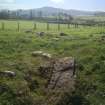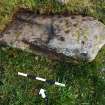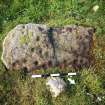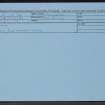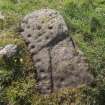Leakin
Cairn (Period Unassigned), Cup Marked Stone (Neolithic) - (Bronze Age)
Site Name Leakin
Classification Cairn (Period Unassigned), Cup Marked Stone (Neolithic) - (Bronze Age)
Canmore ID 16049
Site Number NJ14SE 14
NGR NJ 16450 42060
Datum OSGB36 - NGR
Permalink http://canmore.org.uk/site/16049
- Council Moray
- Parish Knockando
- Former Region Grampian
- Former District Moray
- Former County Morayshire
NJ14SE 14 1645 4206.
Surmounting a rise at NJ 1645 4206 is a robbed cairn, surviving as a flat-topped turf-covered mound, measuring 14.0m N-S by about 16.0m transversely and c.1.1m high. A few kerb-stones are visible in the N and S, but the W and E arcs are obscured by modern field clearance. It is locally thought to be the remains of a chapel. Near the centre of the cairn is a partially buried prostrate rectangular block c.1.2m by c.0.6m bearing at least twenty cup-marks.
Surveyed at 1/2500.
Visited by OS (A A) 4 March 1971.
Note (12 August 2020)
Date Fieldwork Started: 12/08/2020
Location Notes: The panel lies in the centre of a robbed grass-covered cairn which has several large stones protruding from the surface. The cairn is surrounded by a broken fence and is open to grazing by sheep and cattle. The area outwith the broken fence is arable and pasture. Within the same field as the robbed cairn is a long, broken stone wall running N to S, made up of large field boulders. There are no other sites within 200m. The site has large panoramic views over the Spey Valley toward Ben Rinnes to the SE.
Panel Notes: The panel is a rectangular sandstone stone block measuring 1.2 x 0.6m and 0.2m that lies in grass-covered soil at an angle of 20 degrees within the stone cairn. Its upper surface has natural bedding planes which split the cupmarks into three distinct groups at different level. There are approximately 36 cupmarks and 1 pair of conjoined cups. The 3D model also shows 4 of the cups connected by incised and pecked grooves to form a cross-like motif. The cups are generally shallow in depth compared to their width. No toolmarks were visible. The stone may have at one time have been upright and there is therefore a possibility of cupmarks on the underneath surface.





























